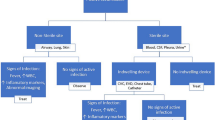Summary
Twelve cases of multiply resistantAcinetobacter calcoaceticus bacteremia occurred in three intensive care units in three different outbreaks. All patients were mechanically ventilated, on broad spectrum antibiotics and had central lines when bacteremia occurred. The sites of primary infection were: abdominal (n=3); respiratory (n=4); central lines (n=4); CNS (n=1). In eight cases the acinetobacter strains were susceptible to ciprofloxacin only. Four other strains were sensitive to amikacin as well. All 11 patients treated with ciprofloxacin alone (seven) or in combination with amikacin (four) fully recovered from the infection. The 12th patient died before antibiotic susceptibility was available. Ciprofloxacin seems to be an excellent therapeutic agent forA. calcoaceticus infections.
Zusammenfassung
Während drei verschiedener Ausbrüche traten in drei Intensivstationen 12 Fälle von Bakteriämie durch multiresistente Stämme vonAcinetobacter calcoaceticus auf. Als die Bakteriämie auftrat, wurden alle diese Patienten künstlich beatmet, erhielten Breitspektrumantibiotika und hatten zentrale Gefäßkatheter. In drei Fällen war die Primärinfektion im Abdomen, in vier Fällen in den Atemwegen lokalisiert, viermal handelte es sich um Katheterinfektionen und einmal um eine ZNS-Infektion. In acht Fällen waren die Acinetobacter-Stämme nur gegen Ciprofloxacin empfindlich. Bei vier Stämmen bestand auch Empfindlichkeit gegen Amikacin. Alle mit Ciprofloxacin allein (sieben) oder in Kombination mit Amikacin (vier) behandelten Patienten erholten sich vollständig von ihrer Infektion. Der 12. Patient starb bevor die Resistenztestung vorlag. Ciprofloxacin ist offensichtlich ein ausgezeichnetes Therapeutikum zur Behandlung von Infektionen durchA. calcoaceticus.
Similar content being viewed by others
References
Baumann, P. Isolation of acinetobacter from soil and water. J. Bacteriol. 1, 96 (1968) 39–42.
Rosenthal, S. L. Sources of pseudomonas and acinetobacter species found in human culture materials. Am. J. Clin. Pathol. 62 (1974) 807–811.
Buxton, A. E., Anderson, R. L., Werdegar, D., Atlas., E. Nosocomial respiratory tract infection and colonization withAcinetobacter calcoaceticus. Am. J. Med. 65 (1978) 507–513.
Raz, R., Alroy, G., Sobel, J. D. Nosocomial bacteremia due toAcinetobacter calcoaceticus. Infection 10 (1982) 168–171.
Larson, E. L. Persistent carriage of gram-negative bacteria on hands. Am. J. Infect. Control 9 (1981) 112–119.
Glew, R. H., Moellering, R. C. Jr., Kunz, L. Infection withAcinetobacter calcoaceticus Herellea vaginicola: Clinical and laboratory studies. Medicine 56 (1977) 79–97.
Smego, R. A. Jr. Endemic nosocomialAcinetobacter calcoaceticus bacteremia. Clinical significance, treatment and prognosis. Arch. Intern. Med. 145 (1985) 2174–2179.
Larson, E. A decade of nosocomial Acinetobacter. Am. J. Infect. Control. 12 (1984) 8–14.
Castle, M., Tenney, J. H., Weinstein, M. P. Outbreak of multiply resistant Acinetobacter in a surgical intensive care unit: Epidemiology and control. Heart Lung 7 (1978) 641–644.
National Committee for Clinical Laboratory Standards (NCCLS): Performance standards for antimicrobial disk susceptibility tests. Villanova, PA, NCCL8 (1983).
Centers for Disease Control: Acinetobacter calcoaceticus: Common nosocomial organism, uncommon pathogen, in national nosocomial infection study report. Annual summary 1976, Atlanta (1978, 1) 114–120.
Ramphal, P., Kluge, R. M. Acinetobacter calcoaceticus varietas antitratus. An increasing problem. Am. J. Med. Sci. 277 (1979) 57–66.
Neu, H. C. Structure activity relation of new beta-lactam compounds andin vitro activity against common bacteria. Rev. Infect. Dis. 5 (Suppl.) (1983) S319-S337.
Wolfson, J. S., Hooper, D. C. The fluoroquinolones: structures, mechanisms of action and resistance, and spectra of activityin vitro. Antimicrob. Agents Chemother. 28 (1985) 581–586.
Mulligan, M. E., Ruane, P. J., Johnston, L., Wong, P., Wheelock, J. P., MacDonald, K. Ciprofloxacin for eradication of methicillin-resistantStaphylococcus aureus colonization. Amer. J. Med. (Suppl. 4a) (1987) 215–219.
Lesse, A. J., Freer, C., Salata, R. A., Francis, J. B., Scheld, W. M. Oral ciprofloxacin therapy for gram-negative bacillary osteomyelitis. The Am. J. Med. 82 (Suppl. 4A) (1987) 247–253.
Bauernfeind, A. Antimicrobial activity of ciprofloxacin: an overview. In:Neu H. C., Weuta, H. (eds.): First international ciprofloxacin workshop. Excerpta Medica, Amsterdam (1986) pp. 7–10.
Author information
Authors and Affiliations
Rights and permissions
About this article
Cite this article
Leonov, Y., Karpuch, J., Lewinson, G. et al. Ciprofloxacin in the treatment of nosocomial multiply resistant Acinetobacter calcoaceticus bacteremia. Infection 18, 234–236 (1990). https://doi.org/10.1007/BF01643395
Received:
Accepted:
Issue Date:
DOI: https://doi.org/10.1007/BF01643395




